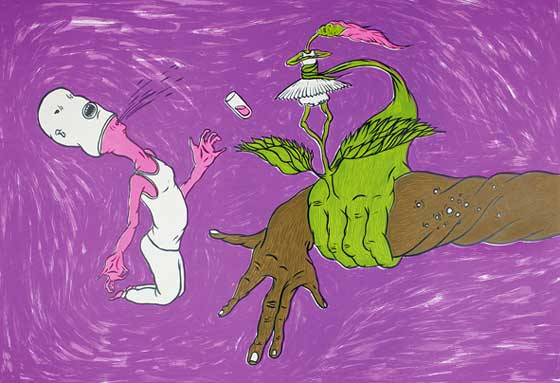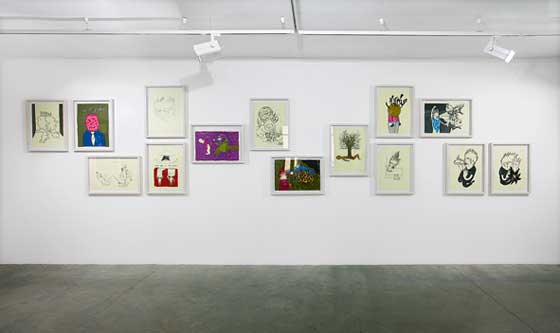|
|
| A parade of hobgoblins and the adolescent in us Stella Pelše, Art Historian Maija Kurševa. Three-Legged Case 07.08.–29.08.2010. kim? Gallery VKN | |
| “The closest beer drinking spot is in these bushes. A lad also lives nearby, with the sharpest brow in the district, devotes himself to his work completely. Behind the third bush there’s a newspaper smoker, hiding [..]. The drunken layabout and the tramp are again chatting about their red velvet tent, which they’ll never construct. The aubergine has gorged on marrows to the extent that his arse is already dragging along the ground, he is angry. In horror the poet covers his face with his hands [..]. Every story is about animals and love, even this one, with some sort of smear at the end [..]. The gnarled tree has a clump of grass growing between its legs. They have both hidden a one-armed torso, dressed in an undershirt, in the cupboard, it was such a beautiful creature that the many who wanted it started pulling it to pieces. [..] Once a week the black head in red trousers visits the Forest Mother to cry, the Forest Mother tries to explain to the head that this life is the dearest and always prepares it some nasty little surprise as a farewell, but doesn’t say why. The black head has placed its palm with outstretched fingers on a tree-stump, a knife in the other hand, there’s a script in the mushrooms that it has an unfocused stare. It sits in silence, and doesn’t say that they’ve come to rescue their relative who has got all tied up in black nets right there by the stump, the captured mushroom has completely dried up and baring its little dry teeth, snorts…” What is that? A record of nightmares and hallucinations? These are fragments of a story told by a soft, puff ball-like hobgoblin speaking in a man’s hoarse voice at Maija Kurševa’s latest exhibition, where pictures on the wall illustrate the stream of consciousness fixed in a sound recording. In it, higgledy-piggledy and all mixed up are the motifs of destruction, erotica and drug dependency, and in the search for the beginnings of the paradoxical composition one could even stray as far as the provocations of Dadaism and surrealism, for example, Salvador Dali’s ‘critical paranoia’. | |
 Maija Kurševa. Nettle. Silkscreen. 42x59.4cm. 2010. Courtesy: Maija Kurševa | |
| Still, it is doubtful whether it’s worth looking for a similar symbolic web of meaning, where “ants mean decomposition, a man’s superhuman sized hand – masturbation, grasshoppers – Dali’s childhood phobias, trousers stained with faeces – shame and repressed sexuality”.(1) As opposed to the 1920s–1930s, when such motifs seemed revolutionary, the possibilities to shock today have shrunken radically, however it’s unlikely that they have been completely exhausted (especially in the local context), and in the migration of adolescent subculture to exhibition halls definitely something can still be found. The Kurševa phenomenon in Latvian art doesn’t have many counterparts, although some pop culture elements, for example, in the paintings of the younger generation, can be found. The ‘Bad Girl’ who studied at the Visual Communications Department of the Art Academy of Latvia and the Berlin University of the Arts (UdK), and “chooses to be not very polite”(2) in the context of art by the generous use of bad language in printed texts, has synthesized her style from the domain of comics and caricatures with the use of drawings, installations, video and other means of expression. Thus her project Ļaunuma sakne (‘The Root of Evil’) offered an urban folklore horror story with a tree lit up in the dark and strange creatures perched in it. “Rumours are circulating that it is quite a terrible place, where small green confused human-like creatures come into being. They then spread throughout the whole city like a type of flu virus.” (from the Urbanoloģika exhibition, 2007). Kurševa’s green, large-headed little people with what seem like amputated extremities have been noticed migrating into the public space as well, but one such example in a green giant spacesuit at a bottle covered table (Mana piektdiena – ‘My Friday’ installation, 2008) has even become a part of a master’s work, together with a theoretical investigation into “alcoholism and its portrayal in art”(3). | |
 View from the exhibition 'Three-Legged Case' of Maija Kurševa. 2010. Photo: Martins Vizbulis | |
| One of the traditional ways of creating caricature is to illustrate literally some figuratively expressed idea. This gains quite a bloody tinge in the latest exhibition. For example, the baker, who “devotes himself completely to his work”, converting his arms into sliceable lengths of sausage using a knife, which just like the scissors of film hero Edward Scissorhands has grown in place of his hand. In addition to the approximate and often amusing people who have transformed into mutants, who curse, vomit and take up pornographic poses, Kurševa’s absurd stories are populated by nimbly moving trees, vegetables and mushrooms, but this whole set of unpleasant faces is reminiscent of the visualized microbe army from the Domestos cleaning liquid advertisement. The strong drink theme is manifested in busy bottles endowed with arms and legs, which are similar to some Soviet era anti-alcohol propaganda material seen a long, long time ago. These scenes don’t form any kind of single story, as is usual with comics, but rather remind one of the unconnected scribbled sketches which teens draw on their classroom benches, toilet walls or some other improvised spot during breaks. The exhibition’s ‘expansion’ into the urban environment is confirmed by the painting in the common entrance at Bruņinieku iela 22, depicting an extraterrestrial creature of jelly-like consistency, as well as the squatting of three brown ‘puffballs’ on the roof edge of the workshop building at Andrejsala. The better-trained visitors were able to get closer to these creatures also through the roof hatch. What to make of all this? Kurševa’s own comments are of use, to prevent one from reading into it some over-serious critical message: “My works aren’t critical of consumer society, it’s more that they are a bit of a joke. They’re not so intellectual that you should stand in front of them in the gallery thinking long and hard, then to go home and... Absolutely anyone can be the viewer. They don’t have to be familiar with the history of art.”(4) So – one has to rely on one’s everyday experience and decide whether, in delving into such a field of ‘low art’, it really is funny. Laughing is known to be one of the healthiest activities, which can also make you see yourself and the world in a new light. However, it must be conceded that the ability to laugh about what one sees is quite dependent n the viewer’s cultural diet; whether it will all seem ‘funny’ or rather ‘foolish’ can also differ among age groups and can balance perilously on the border of an infantile psyche. At the same time, appreciating the adolescent in oneself is no bad thing, and perhaps adolescents themselves may become interested in art for the first time, if it can also be like this. (1) Veijers F. Salvadors Dalī: Dzīve un darbi. Rīga: Jāņa Rozes apgāds, 2006, p. 32. (2) Vējš V. Nejaukā meitene. Diena, 21 August, 2010 (3) Salmanis K. Kas padodas Maijai Kurševai, Studija, 2008, No. 62 (October/November), p. 54. (4) Ibid., p. 63. /Translator into English: Uldis Brūns/ | |
| go back | |







